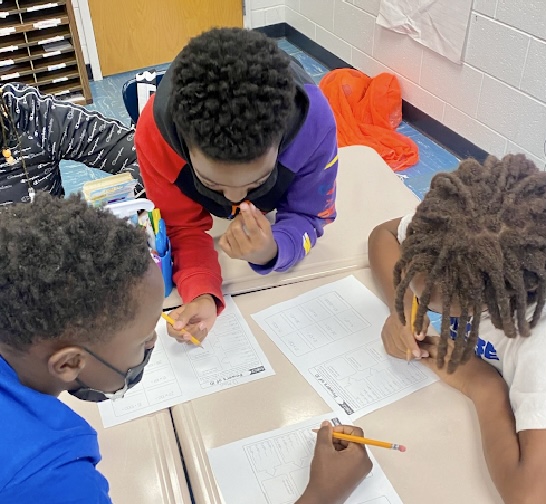Ed Dept. Gives School Districts an Additional 18 Months to Use Federal Funds on Construction Projects

Get stories like this delivered straight to your inbox. Sign up for The 74 Newsletter
Updated May 13
The U.S. Department of Education on Friday responded to superintendents’ January request for more time to spend pandemic relief funds on school construction projects and facility upgrades.
As long as districts obligate the funds by Sept. 30, 2024, as the American Rescue Plan requires, “grantees may have up to 18 months beyond the end of the obligation period” to spend the money, Roberto Rodriquez, assistant secretary of planning, evaluation and policy development, said in the letter to Dan Domenech, executive director of AASA, the School Superintendents Association.
Supply chain delays, labor shortages and inflation have interfered with districts’ efforts to hire contractors and start projects.
As the nation’s school superintendents gathered last month for their first in-person meeting since the pandemic began, Dan Domenech, the organization’s leader, pressed U.S. Education Secretary Miguel Cardona about an urgent issue.
At Music City Center in Nashville, he reminded the secretary that districts were anxious about hitting a September 2024 deadline for obligating funds from the $1.9 trillion American Rescue Plan. Due to the escalating cost of materials, supply chain delays and labor shortages, less than half of his members were on track to meet the cut-off date, according to a survey taken that month by the organization, the AASA. He asked Cardona if the department would heed a January request from more than 30 education organizations for a two-year extension on dedicating the funds to school facility projects.
No luck.
“He was sympathetic, but he didn’t give an answer,” said Domenech, the AASA’s executive director. Districts, Domenech said, don’t want to be “forced to spend the money and then be criticized for how they spent it.”
That’s likely to be unwelcome news for the White House, where the pandemic relief bill stands as one of President Joe Biden’s few legislative victories in a year marked by partisan wrangling over COVID, record-level inflation and the failure to pass Build Back Better, the other major piece of the administration’s domestic agenda. With few strings attached, the American Rescue Plan, signed a year ago on March 11, 2021, provided an unprecedented $122 billion for K-12 schools to reopen and rapidly respond to students’ learning and social-emotional deficits from the pandemic. Experts say that’s a key reason why the administration would likely frown on dragging out the timeline to use the money.
Congress might not like the idea either.
“I’m dubious that Congress would extend the deadline” for obligating the education funds, said Julia Martin, legislative director at Brustein and Manasevit, a law firm specializing in education. Members, she said, would be faced with questions over whether an extension undermines the original purpose of the legislation, which was to address an emergency.
Marguerite Roza, executive director of the Edunomics Lab at Georgetown University, added, “No one wants to open up that law again because it was not bipartisan.” Democrats passed the relief bill using a process known as reconciliation that didn’t require any Republican votes.
Roza, who argues that addressing learning loss needs to be districts’ top priority, said that extending the deadline for construction projects would only draw attention to how officials are using the funds for non-academic reasons.
‘The great things’
Cardona, meanwhile, reiterated his expectation that districts use the money now to benefit students.
“Texas received $12 billion, with a B,” Cardona said Wednesday during a morning keynote session at SXSW EDU in Austin. “It needs to touch the classrooms now.”
His comment came in response to high school senior Gesenia Alvarez, who described how her school’s college and career center shut down when schools reopened, leaving students without help to fill out college and financial aid forms.
“I want to make sure as we see now masks off and things are starting to look normal,” Cardona said, “that we do not lose our sense of urgency around not only the gaps that existed before but the gaps that have been made worse” by the pandemic.
Last week, while talking with leaders of the National Association of Elementary School Principals, he pointed to a recent analysis by FutureEd, a think tank at Georgetown University, that showed how districts educating 60 percent of the nation’s children could potentially spend the funds by the 2024 deadline, directing at least $31 billion of that money to academic recovery, $25 billion to staff and $26 billion to facilities and operations.
A statement from the education department to The 74 acknowledged that officials have “heard about supply chain concerns for projects like HVAC upgrades and [are] looking at what might be possible to help alleviate those issues. We will continue to work with states and districts to make sure these funds are used swiftly and effectively to keep schools safely open for in-person instruction and address students’ needs.”
Noelle Ellerson Ng, associate executive director of advocacy and governance at AASA, said that any deadline extension would likely come from the department, not Congress. The department, she said, could use “technical authority to address timeline flexibilities.”
She added that Republicans might use any extension to argue in the midterm elections that schools didn’t need that much funding, while Democrats might want to see it spent faster to prove that they did. Both arguments “miss the mark,” she said.
“The law provides three years, and if schools plan a multi-year drawdown and act in a fiscally prudent manner that focuses on student learning recovery, that is what should matter,” she said.
Districts were also hoping for dedicated federal funds for school construction that never materialized. That put “reverse pressure” on districts’ relief funds, Ng said, and schools now have “one pot of funding with which to address student learning and anything they might be able to do in terms of infrastructure in the context of COVID.”

Ian Rosenblum, who recently left the Department of Education after serving as acting assistant secretary of the Office of Elementary and Secondary Education, also highlighted the FutureEd report, which showed that districts had plans for spending $50 billion of the $67 billion they were receiving.
“When we speak with superintendents, we are hearing about the great things they’re doing right now to use federal pandemic recovery funds,” said Rosenblum, principal at ILO Group, a consulting firm working with districts on recovery plans. “The most urgent need is to tell those stories and to support districts in getting that work done.”
Mary Elizabeth Davis, superintendent of the Henry County Schools, outside Atlanta, said her district has dedicated $53 million in relief funds toward three priorities: teaching materials and training — particularly in literacy — student well-being, and employee health and wellness. The district has also planned some facility upgrades.

Every school now has a health and wellness “facilitator” who addresses issues ranging from chronic absenteeism to food donations for families — tasks that used to be “sporadically dispersed between good-natured staff in the building,” Davis said. “We have seen so much out of that one position. It’s unbelievable.”
But she acknowledged the challenges in using the funds to modernize schools.
“All of our bids are coming in higher than estimated,” she said. “The marketplace demands that exist in the larger community — we’re not immune to that.”
But superintendents’ concerns about making best use of the funds go beyond facility-related expenses. Domenech said he’d like to see a general extension of the deadline.
John Malloy, superintendent of the San Ramon Valley Unified School District, east of Oakland, California, said districts want to use the relief funds to respond to the increased mental health demands of students — an issue Biden addressed during his State of the Union address last week. But schools were short on counselors, social workers and psychologists before the pandemic and now report even more difficulties hiring those professionals.
“When you try to spend too quickly,” Malloy said, “you use dollars for things that don’t move your students forward.”
Putting up ‘guardrails’
According to the law, districts have to commit to spend the dollars by the end of September, 2024, and then have another 120 days to finish spending it. Thomas Toch, the director of FutureEd, explained that just because districts are obligating the funds doesn’t mean they won’t struggle to fill positions or face backlogs in building materials. An earlier analysis by his center showed that rural and high-poverty districts are more likely to direct relief funds toward “long-standing deferred maintenance and capital expenditures.”
Lining up contractors takes time, he said, adding that he doesn’t think AASA’s request for an extension is unreasonable.
“But you want to put [up] some guardrails — that it is long-term capital projects they are deferring and not efforts to address learning loss,” he said. He urged districts struggling to find tutors, for example, to pay high school and college students to work with children in the early grades.
He said he doubts Biden would pay a “political price” for extending the deadline to spend the funds. In fact, he added, “To the extent that government spending is contributing to inflation, extending the spending timeline would be a plus.”
Supply chain delays and labor shortages aren’t the only issues interfering with districts’ plans to spend the relief funds. In some cases, the funds aren’t reaching the local level.
In Wyoming, state lawmakers last month debated whether to cut some of the relief funds from the education budget, even though districts have already planned staff bonuses using that money. And in Massachusetts, Secretary of Education James Peyser said during a February state board meeting that of the $2.6 billion in relief funds available, districts have so far applied for only $400 million to $450 million.
“That leaves well over $2 billion that is still on the table for school districts to pull down,” he said.
‘In the weeds’
Julia Rafal-Baer, founder of the ILO Group, said one obstacle to liquidating the relief funds is that districts sometimes lack the accounting staff to handle such a significant new pot of money. She added that in some districts, newly elected school board members are “taking on larger roles that include getting far more into the weeds, which impacts the ability of leaders to use the money in the way the community is expecting.”
She pointed to the Akron, Ohio, school district where board members recently rejected Superintendent Christine Fowler Mack’s request to use American Rescue Plan funds for additional central office positions, including a chief of extended learning.
Parent advocates, however, have little sympathy for districts seeking additional time. Keri Rodrigues, president of the National Parents Union, an advocacy organization, said districts have not acted with urgency.
“There is so much buck-passing,” she said. “We are going to be holding superintendents’ feet to the fire to spend this money faster.”
Get stories like these delivered straight to your inbox. Sign up for The 74 Newsletter

;)
